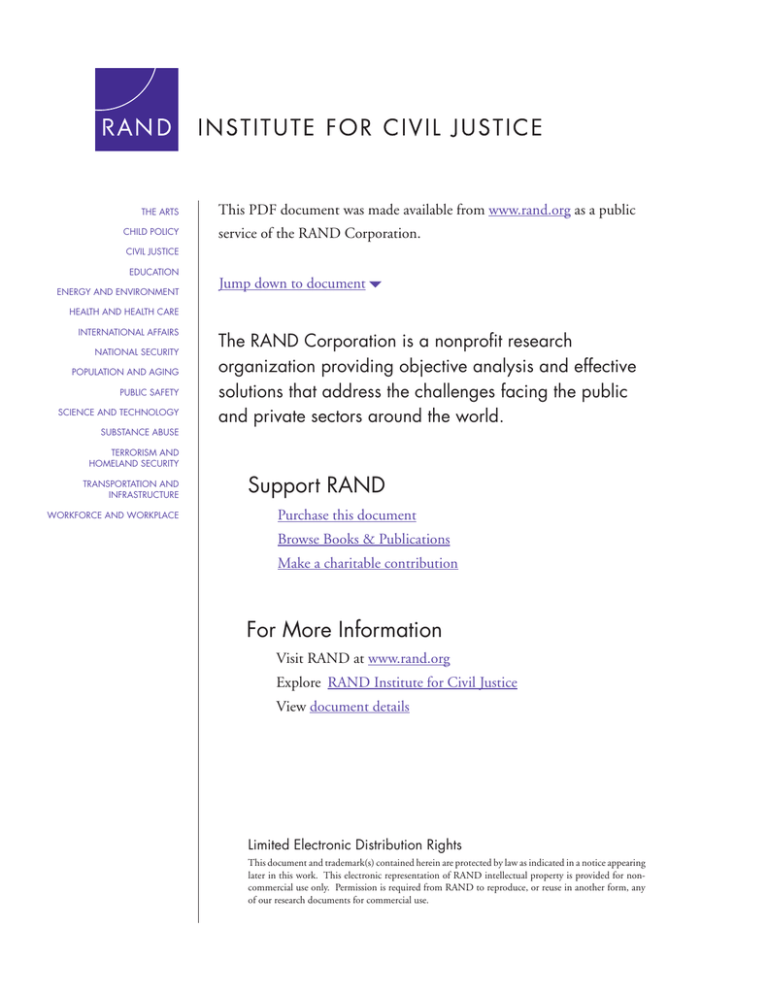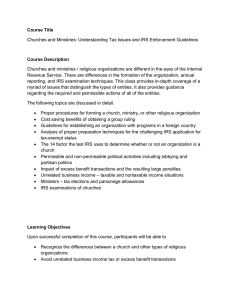
THE ARTS
CHILD POLICY
This PDF document was made available from www.rand.org as a public
service of the RAND Corporation.
CIVIL JUSTICE
EDUCATION
ENERGY AND ENVIRONMENT
Jump down to document6
HEALTH AND HEALTH CARE
INTERNATIONAL AFFAIRS
NATIONAL SECURITY
POPULATION AND AGING
PUBLIC SAFETY
SCIENCE AND TECHNOLOGY
SUBSTANCE ABUSE
The RAND Corporation is a nonprofit research
organization providing objective analysis and effective
solutions that address the challenges facing the public
and private sectors around the world.
TERRORISM AND
HOMELAND SECURITY
TRANSPORTATION AND
INFRASTRUCTURE
WORKFORCE AND WORKPLACE
Support RAND
Purchase this document
Browse Books & Publications
Make a charitable contribution
For More Information
Visit RAND at www.rand.org
Explore RAND Institute for Civil Justice
View document details
Limited Electronic Distribution Rights
This document and trademark(s) contained herein are protected by law as indicated in a notice appearing
later in this work. This electronic representation of RAND intellectual property is provided for noncommercial use only. Permission is required from RAND to reproduce, or reuse in another form, any
of our research documents for commercial use.
This product is part of the RAND Corporation technical report series. Reports may
include research findings on a specific topic that is limited in scope; present discussions of the methodology employed in research; provide literature reviews, survey
instruments, modeling exercises, guidelines for practitioners and research professionals, and supporting documentation; or deliver preliminary findings. All RAND
reports undergo rigorous peer review to ensure that they meet high standards for research quality and objectivity.
The Bankruptcy Abuse
Prevention and Consumer
Protection Act of 2005
Evaluation of the Effects of Using
IRS Expense Standards to
Calculate a Debtor’s Monthly
Disposable Income
Stephen J. Carroll, Noreen Clancy, Melissa A. Bradley,
Jennifer Pevar, Marianne Culhane, Michaela White
Prepared for the Executive Office for U.S. Trustees
The research described in this report was prepared for the Executive Office for U.S. Trustees
by the RAND Institute for Civil Justice.
Library of Congress Cataloging-in-Publication Data
The Bankruptcy Abuse Prevention and Consumer Protection Act of 2005 : evaluation of the effects of using IRS
expense standards to calculate a debtor’s monthly disposable income / Stephen J. Carroll ... [et al.].
p. cm.
Includes bibliographical references.
ISBN 978-0-8330-4183-8 (pbk. : alk. paper)
1. United States. Bankruptcy Abuse Prevention and Consumer Protection Act of 2005. 2. Bankruptcy—
United States—Accounting. 3. Debtor and creditor—United States. 4. Income tax deductions for expenses—
United States. I. Carroll, Stephen J., 1940–
KF1539.B36 2007
346.7307'8—dc22
2007021207
The RAND Corporation is a nonprofit research organization providing objective analysis
and effective solutions that address the challenges facing the public and private sectors
around the world. RAND’s publications do not necessarily reflect the opinions of its
research clients and sponsors.
R® is a registered trademark.
© Copyright 2007 RAND Corporation
All rights reserved. No part of this book may be reproduced in any form by any electronic or
mechanical means (including photocopying, recording, or information storage and retrieval)
without permission in writing from RAND.
Published 2007 by the RAND Corporation
1776 Main Street, P.O. Box 2138, Santa Monica, CA 90407-2138
1200 South Hayes Street, Arlington, VA 22202-5050
4570 Fifth Avenue, Suite 600, Pittsburgh, PA 15213-2665
RAND URL: http://www.rand.org/
To order RAND documents or to obtain additional information, contact
Distribution Services: Telephone: (310) 451-7002;
Fax: (310) 451-6915; Email: order@rand.org
Executive Summary
One of the main changes introduced by the Bankruptcy Abuse Prevention and Consumer Protection Act of 2005 (BAPCPA) was the requirement that certain debtors filing for bankruptcy
use IRS expense standards for certain expense categories rather than their current expenses
to calculate their monthly disposable income (MDI). This change can affect both the options
available to a debtor considering filing for bankruptcy and the amount the debtor must pay to
creditors under a repayment plan.
In this RAND Corporation study, we assessed the effects of this change on debtors and
the courts. We conducted the research in three steps: First, we reviewed the case law to identify
relevant issues; second, we conducted interviews and focus groups with those involved in the
bankruptcy process to understand background and context; and third, we examined samples
of bankruptcy cases filed in eight judicial districts to estimate the effects of using the IRS standards to calculate a debtor’s MDI.
Effects on the Courts
BAPCPA took effect too recently for appellate courts to have had time to settle the many open
questions. Because there is considerable lack of uniformity among judicial districts in application of the IRS standards in chapters 7 and 13 of the Bankruptcy Code, similarly situated
debtors may have substantially different payment obligations depending on the jurisdiction in
which they live.
Most judges report that each bankruptcy case now requires more of their time, but the
effects seem to vary greatly depending on the district. The increase in workload is not attributable to any particular provision of the new law; therefore, what portion may be due to the IRS
expense standards is not known.
Results of Analysis of Bankruptcy Cases
Fraction of Chapter 7 Cases Using the IRS Standards
About 7 percent of the Chapter 7 debtors in our samples had above-median incomes, but
their deductions, including those calculated using IRS standards, resulted in MDIs that met
the Chapter 7 criteria. The percentage of debtors who filed for Chapter 7 even though their
ix
x
The Bankruptcy Abuse Prevention and Consumer Protection Act of 2005
incomes exceeded the applicable median varies considerably across the country. We have no
data on the extent to which the IRS standards, as part of the means test, may have deterred
debtors from filing under Chapter 7.
Fraction of Chapter 13 Cases Using the IRS Standards
Slightly more than one-quarter of Chapter 13 debtors in our samples had above-median
incomes and, consequently, were required to use the IRS expense standards to calculate their
MDIs. Almost three-quarters of the debtors in our samples who filed under Chapter 13 had
below-median incomes. These debtors presumably could have filed under Chapter 7 had they
so chosen but opted for Chapter 13 filing instead.
There was substantial variation across judicial districts in the fraction of Chapter 13 filers
whose incomes exceeded the median and, consequently, used the IRS expense standards in
calculating their MDIs.
Effects of Using the IRS Standards in Calculating MDI
In every sampled district, the average deductions allowed under the IRS standards are considerably higher than the average equivalent deductions based on reported current expenses.
Higher deductions result in lower MDIs. MDI is reduced by an average of $490 in all sampled
districts combined when the IRS standards are used. In individual districts, the average reduction in MDI due to the use of the IRS standards ranges from $311 in the Middle District of
Florida to $612 in the Northern District of Ohio. The IRS standards result in larger deductions, on average, and, therefore, lower MDIs across the country.
Effects of Specific IRS Standards
Two of the IRS standards primarily account for this differential. The IRS standards for living
expenses and for transportation ownership are generally favorable to debtors. In every sample
district, these IRS standards allow debtors deductions that exceed their reported current
expenses. Conversely, in every sample district, the IRS standards for nonmortgage housing
expenses and for vehicle operation and public transportation allow debtors lower deductions
than their reported current expenses. The IRS standard for mortgage or rental expenses generally favors owners, though the differences between the deduction that owners are allowed
using the IRS standards and their current expenses in that category generally are not large. The
effects on renters of using the IRS standards for mortgage or rental expenses are mixed. In five
of the eight sample districts, using the IRS standards results in smaller deductions, on average,
than does using current rental expenses. In the other three districts, the IRS standard rental
allowance exceeded, on average, the debtors’ current rental expenses.
Effects of Using the IRS Standards on Different Types of Debtors and in Different Districts
Using IRS standards to calculate deductions benefits the average homeowner more than it does
the average renter, but the difference is small, about $65 per month. Among homeowners and
among renters, the only other significant difference in the effects of the IRS standards on different types of debtors is for debtors with high current incomes. In general, higher-income debtors
gain less using the IRS standards rather than their current expenses than do otherwise similar,
Summary
xi
lower-income debtors. For homeowners, the average difference in deductions calculated using
the IRS standards rather than current expenses is about $70 lower for each additional $1,000
in current monthly income. For renters, the average difference in deductions calculated using
the IRS standards rather than current expenses is about $175 lower for each additional $1,000
in current monthly income. This effect is significant for homeowners and highly significant for
renters. Debtors’ assets, liabilities, and expenditures were not significantly related to the effects
of using the IRS standards in calculating their deductions.
The results for the eight judicial districts examined suggest that, controlling for debtors’
financial characteristics, there are some systematic differences among the districts in the effects
of using the IRS standards instead of the corresponding current expenses to calculate a debtor’s
MDI. The district effect is more pronounced for homeowners than for renters.




